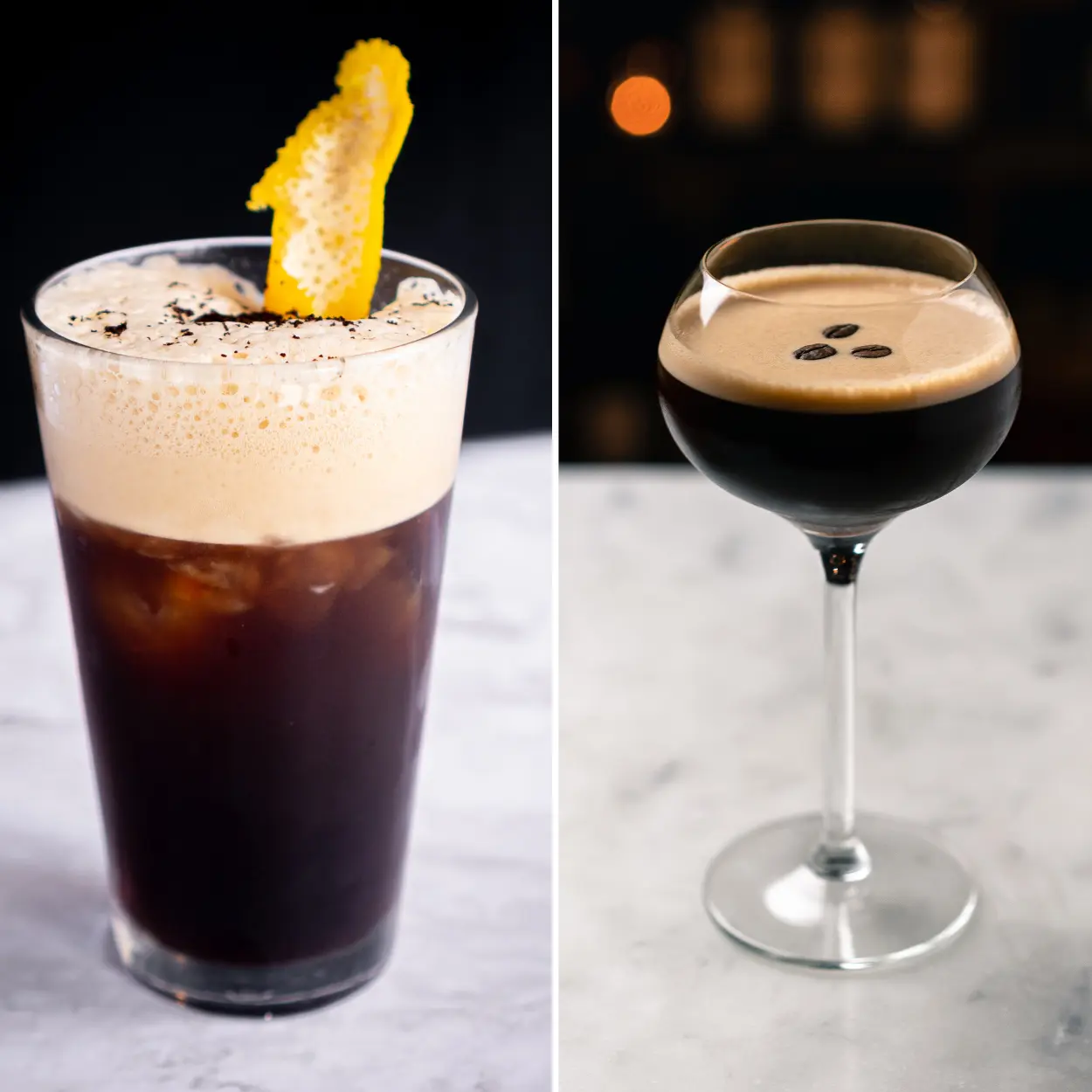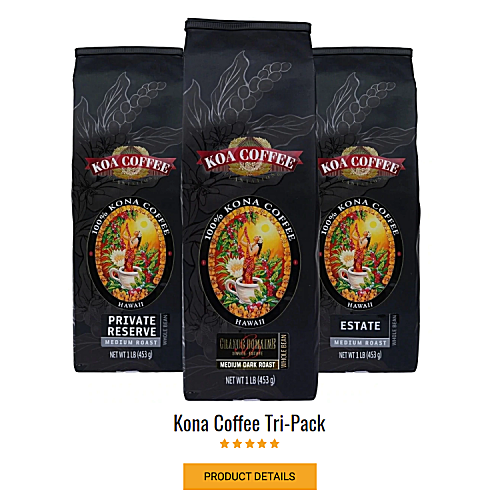The intriguing world of coffee cocktails is a dynamic realm where the invigorating essence of coffee collides with the intoxicating allure of spirits, resulting in an exciting medley of flavors and experiences. At the heart of this narrative is a captivating face-off: Carajillo vs Espresso Martini. Both of these iconic drinks share a common element – coffee, yet they present distinct stories of origin, cultural context, and taste profiles.
On one side of the spectrum is the Carajillo, a drink deeply rooted in Spanish tradition, seamlessly blending the robustness of coffee with the warmth of liquor. This cocktail is a symbol of Spain’s vibrant coffee culture and the nation’s love for simple, yet impactful flavors.
In stark contrast, the Espresso Martini stands as a beacon of modern mixology. Born amidst the buzz of London’s lively nightlife, this cocktail represents the perfect fusion of coffee’s vivacity and vodka’s punch, all encased within the refined elegance of a martini glass.
In the ensuing guide, we’ll delve into the rich histories of these beverages, analyze their unique ingredients and preparation methods, and draw a comprehensive comparison between the Carajillo drink and the Espresso Martini. So whether you’re a coffee enthusiast, a cocktail connoisseur, or a budding home bartender, this exploration promises to be an enlightening and enjoyable ride. Ready to embark on this aromatic journey and unravel the world of coffee cocktails? Let’s dive right in.
Carajillo vs Espresso Martini: Key Takeaway
- Flavor Adventure: Understanding the unique taste experiences offered by Carajillo and Espresso Martini is pivotal. Carajillo presents a robust coffee taste intertwined with the complexity of brandy, rum, or coffee liqueurs. In contrast, Espresso Martini serves a smooth blend of coffee’s intensity and vodka’s smoothness.
- Cultural Footprints: Appreciating the rich cultural heritages of both beverages adds depth to our understanding. Carajillo is steeped in Spanish and Latin American traditions, whereas Espresso Martini, a British creation, symbolizes modern cocktail culture’s international reach.
- Perfect Occasions: Knowing the ideal setting for each cocktail enhances enjoyment. Typically, Carajillo shines as a post-meal digestive or a cozy winter warmer, while Espresso Martini brings sophistication and fun to parties and social events.
- Crafting Magic: Grasping diverse ingredients and preparation techniques is crucial. Carajillo involves the warming of spirits, often with flavorful extras, while the creation of an Espresso Martini requires shaking the components with ice and straining the blend into a glass.
- Adapt and Experiment: Recognizing the multitude of variations and adaptations available for both drinks allows for endless customization. With Carajillo, the spirit choice varies with geography, while Espresso Martini sees modern twists through flavored liqueurs or unique garnishes. Such adaptability keeps the beverages exciting and suited to personal tastes.
Understanding the Coffee Cocktail Universe
As we journey into the world of coffee cocktails, it’s essential to comprehend the broader landscape before delving into our Carajillo vs Espresso Martini face-off.
The Rising Popularity of Coffee Cocktails

The rise of coffee cocktails has been nothing short of meteoric. Coffee, with its bold flavors and inherent complexity, has long been a staple in various cultures worldwide. Recently, it has found its place in the realm of mixology, giving birth to an entirely new category of drinks known as coffee cocktails.
These beverages are quickly becoming the choice of many cocktail enthusiasts and coffee aficionados alike. The surge in their popularity can be attributed to a few key factors:
- Novelty: The fusion of coffee and alcohol offers an interesting twist to conventional drinks, appealing to those seeking new flavor experiences.
- Versatility: Coffee cocktails can be served hot or cold, making them suitable for all seasons.
- Complex Flavors: The robust and diverse flavor profile of coffee adds depth to cocktails, creating a rich and layered drinking experience.
Role of Coffee in Mixology
Coffee’s role in mixology extends far beyond merely lending its flavor to a cocktail. As a base ingredient, coffee offers complexity, texture, and balance, much like how citrus or bitters function in traditional cocktails. Its strong flavor profile can stand up to, and complement, a variety of spirits, providing mixologists with a broad canvas to craft their creations.
Moreover, coffee’s diverse range, from light roasts with bright acidity to dark roasts with intense, full-bodied flavors, offers endless possibilities for cocktail innovation. It’s this versatility that has brought us the varied coffee cocktail landscape we see today, including classics like the Irish Coffee, the White Russian, and of course, our protagonists for the day, Carajillo and Espresso Martini.
Key Components of a Coffee Cocktail
Just like any great work of art, a fantastic coffee cocktail is more than just the sum of its parts. Here are the key components that come together to create a well-balanced coffee cocktail:
- Coffee: The quality of the coffee plays a crucial role. Freshly brewed, high-quality coffee ensures the drink has a strong foundation.
- Spirit: The choice of spirit can significantly influence the cocktail’s flavor. The spirit should complement the coffee without overpowering it.
- Sweetener: Sweeteners can help balance the bitterness of the coffee. This could be simple syrup, sugar, or even flavored syrups.
- Additional Flavors: Ingredients like cream, chocolate, spices, or citrus can add layers of flavor and complexity.
- Technique: The method of preparation, including brewing the coffee and mixing the cocktail, is vital for achieving the desired taste and texture.
Unraveling the allure of the Espresso Martini vs Carajillo journey requires an understanding of the coffee cocktail universe. By appreciating the rising popularity of these beverages, the role of coffee in mixology, and the key components of a coffee cocktail, we’re better equipped to dive into the fascinating narratives of these two iconic drinks.
The Tale of Carajillo: History, Ingredients, and Preparation
Embarking on a journey through the captivating world of Carajillo, we explore its storied past, understand its fundamental ingredients, and delve into the multifaceted preparation techniques that breathe life into this intriguing coffee cocktail.
The Spanish Origin Story of Carajillo

Originating from Spain, the Carajillo is a steamy coffee cocktail with an intriguing backstory. It’s not just a drink; it’s a tale of adaptation and integration into diverse Latin American cultures.
- In Colombia, Carajillo is made with brandy.
- In Cuba, rum is the alcohol of choice.
- Mexico favors the addition of mezcal or coffee liqueurs such as Kahlúa or Tía María to the Carajillo.
The cocktail’s colorful past is steeped in legend. As the story goes, during the Spanish colonization of Cuba, soldiers concocted a brew of coffee and rum to bolster their courage. This fortifying mix was dubbed “corajillo,” a diminutive form of “coraje,” the Spanish word for courage. Over time, “corajillo” evolved into “carajillo.” Interestingly, in Catalan, this invigorating concoction is called “cigaló,” while in Italy, a similar drink is known as “caffè corretto.” (1)
How to Make a Perfect Carajillo: Ingredients and Recipe

Creating a perfect Carajillo requires an appreciation of its key components and their perfect equilibrium. The foundational element is robust, freshly brewed coffee, complemented by a spirit—typically brandy, although rum, mezcal, or coffee liqueurs are popular alternatives. Certain versions feature delightful additions like cinnamon and lemon peel.
A Carajillo is not just a cocktail but a manifestation of culture, stemming from Spain and popularized in various Latin American regions. Each region imparts its own unique touch, resulting in a variety of versions of this classic coffee cocktail. As previously mentioned, in Spain, brandy is the spirit of choice, whereas rum is used in Cuba, and in Mexico, the selection leans towards mezcal or coffee liqueurs like Kahlúa or Tía María. Despite these differences, the underlying profile of a strong coffee blend combined with a spirited liquor remains constant.
Here’s a breakdown of a classic Spanish Carajillo recipe:
- 60ml strong, freshly brewed coffee
- 30ml brandy (or other distilled spirit)
- A handful of coffee beans
- 1 strip of lemon peel
- Sugar to taste
- 1 small cinnamon stick (optional)
Follow these steps to create the cocktail:
- Preparation of Spirit: Pour your spirit into a saucepan and warm it gently. To this, add a few coffee beans, a strip of lemon peel, and sugar according to your preference. If you wish, add a small cinnamon stick at this point.
- Flambé Process: Ignite the mixture carefully and let it burn for a minute. This reduces the alcohol content slightly and allows the flavors to integrate.
- Adding Coffee: Extinguish the flame and add your freshly brewed coffee to the mixture. Stir thoroughly.
- Serving: Your Spanish Carajillo is ready to be served hot.
In the American rendition of Carajillo:
- Rim a heated Spanish coffee mug with sugar.
- Add rum and triple sec, and ignite the mixture to caramelize the sugar.
- Extinguish the flame with a coffee liqueur.
- Top off with coffee and whipped cream, and serve.
The Chilled Mexican Version
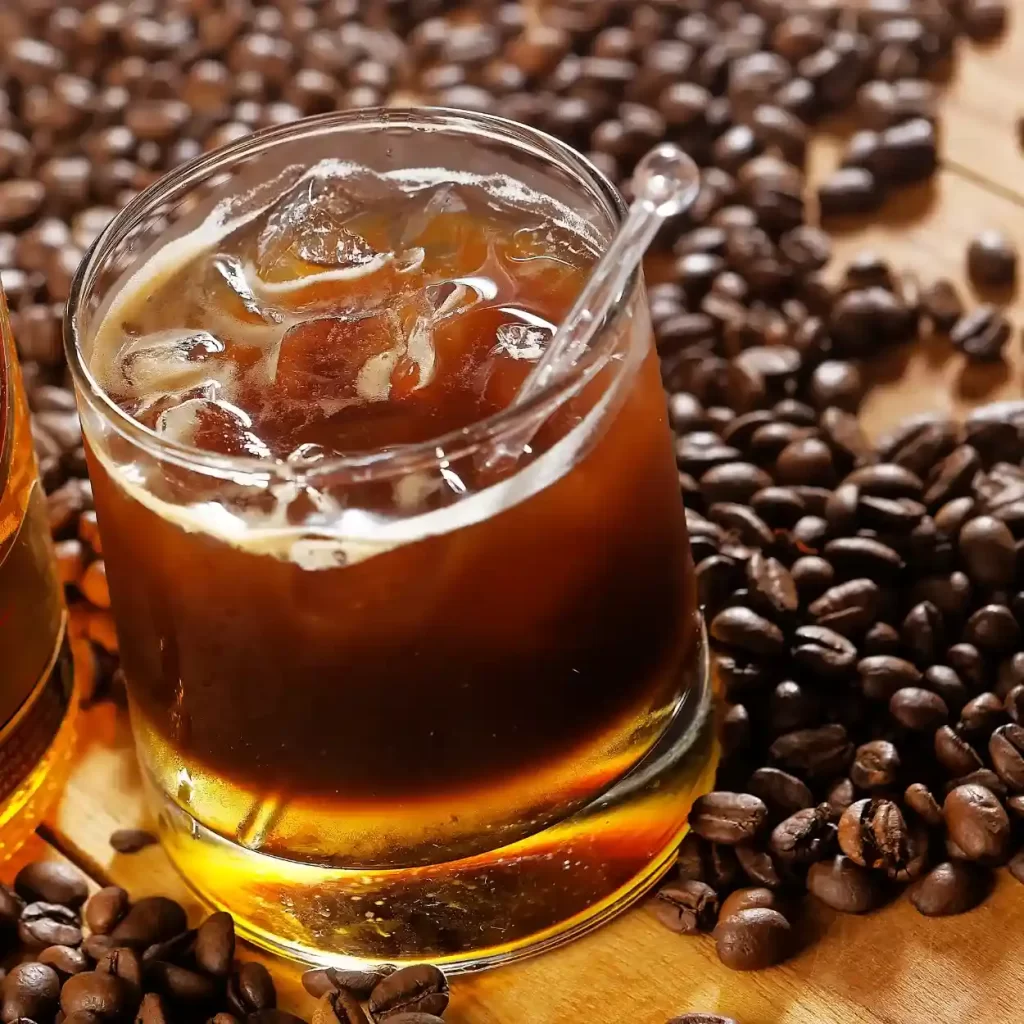
One of the exciting aspects of the Carajillo is its versatility. This enticing beverage seamlessly combines the richness of espresso with the distinctive sweetness of Licor 43, offering a delightful drink experience that can be enjoyed hot or cold. Here’s how you can whip up a chilled Carajillo at home:
Ingredients:
- 1/2 cup of freshly brewed espresso or decaffeinated espresso
- 1 1/2 to 2 ounces of Licor 43
- 8 ice cubes
Instructions:
- Prepare the Glass: Start with a clean, dry Old Fashioned glass. The correct glass can significantly enhance your cocktail experience by concentrating the aromas and evenly cooling the drink.
- Add Licor 43: Pour 1 1/2 to 2 ounces of Licor 43 into the glass. This unique vanilla-citrus-flavored liquor lends the Carajillo its characteristic sweetness.
- Add Ice: Drop a handful of ice cubes over the Licor 43. The ice serves to cool down the cocktail and add a touch of dilution, subtly softening the robust flavors of the espresso and Licor 43.
- Pour the Espresso: Gently pour the freshly brewed espresso over the top of the ice. The robust flavor of the espresso perfectly balances the sweetness of the Licor 43.
- Create the Layered Effect: For a visually striking layered look, consider gently pouring the espresso over the back of a spoon. This technique allows the espresso to settle on top of the Licor 43, creating distinct layers in your drink.
- Serve: Serve the Carajillo with a cocktail stirrer, giving your guests or yourself the pleasure of merging the layers together.
The chilled Carajillo is more than just a coffee cocktail; it’s a sensory delight. It offers a refreshing break on a warm afternoon or a sophisticated cap to a delightful meal.
Variations and Modern Takes on the Classic Carajillo
The Carajillo’s voyage across regions and cultures has led to the birth of intriguing variants and modern adaptations:
- In Catalonia, Carajillo is usually presented in its simplest form: coffee, brandy (unburned), and sugar served separately, allowing the drinker to customize the sweetness.
- The province of Castellón in Spain opts for a more theatrical preparation, involving slightly burning the alcohol with sugar, cinnamon, coffee beans, and lemon peel.
- Mexico offers a chilled rendition popular as a post-meal digestive, combining espresso or strong coffee with “Licor 43″—a sweet, citrusy, vanilla-flavored liquor, served over ice in a short glass.
The Carajillo, with its rich history, diverse ingredients, and variations, stands as a testament to the cocktail’s versatility and enduring appeal. Whether hot or cold, this coffee cocktail continues to allure with its enchanting blend of coffee and spirits.
The Evolution of Espresso Martini: Background, Components, and Making
A deep dive into the realm of Espresso Martini uncovers its fascinating background, takes us through its essential components, and provides insight into the art of crafting this beloved coffee cocktail.
How the Espresso Martini Came to Be
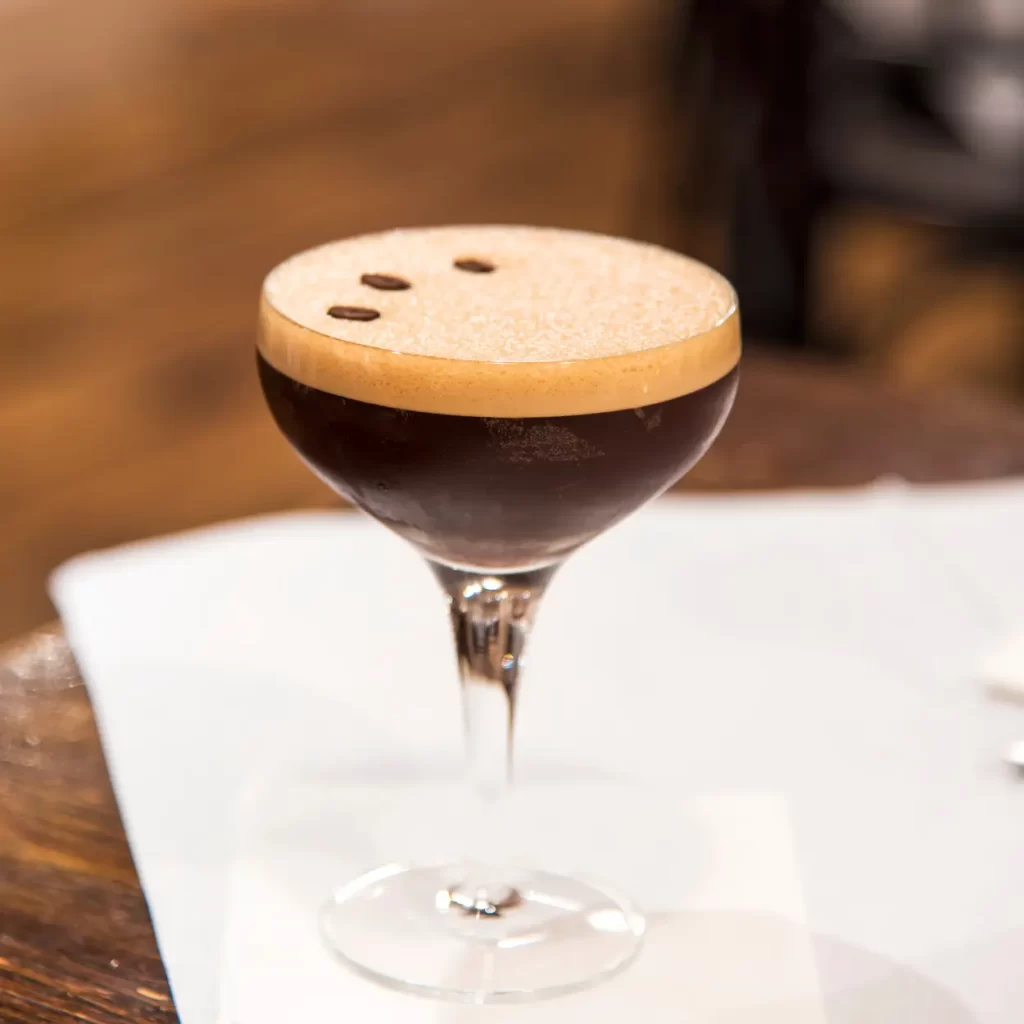
The origins of the Espresso Martini are embedded in the vibrant and evolving cocktail culture of the late 20th century. Conceived in the 1980s by famed British bartender and mixologist Dick Bradsell, the Espresso Martini was reportedly created when a model walked into his London bar and asked for a drink that could “wake her up and mess her up” simultaneously. (2)
Bradsell, always up for a challenge, blended a shot of espresso with vodka, coffee liqueur, and a touch of sugar syrup, shaking it with ice to create a frothy, caffeinated cocktail. The result was initially named “Vodka Espresso,” but as cocktail trends evolved and the Martini craze of the ’90s took hold, it was renamed the Espresso Martini.
Shaking Up an Espresso Martini: Ingredients and Method

The Espresso Martini marries the worlds of coffee and cocktails in a harmonious blend that is both indulgent and invigorating. Here are the key ingredients and steps to crafting your own:
- 30ml Freshly Brewed Espresso: A shot of freshly brewed espresso forms the heart of the cocktail, imparting robust coffee notes.
- 44ml Vodka: A clear, clean vodka provides an alcoholic base.
- 20 ml Coffee Liqueur: A quality coffee liqueur enhances the coffee flavor and adds a hint of sweetness.
- Sugar Syrup: A touch of sugar syrup balances the cocktail and amplifies the flavors.
- Coffee Beans: For garnish.
The method is straightforward:
- Pour the espresso, vodka, coffee liqueur, and sugar syrup into a cocktail shaker.
- Add a handful of ice.
- Shake vigorously for around 20 seconds to create a nice froth.
- Strain into a chilled martini glass.
- Garnish with three coffee beans for good luck, and serve.
Innovation in the Espresso Martini World
As with any classic, the Espresso Martini has not been immune to experimentation and innovation. Mixologists worldwide have taken the basic premise and added their unique twists, resulting in a plethora of exciting variations.
Some bartenders introduce flavored liqueurs or infused spirits, while others experiment with different types of coffee, such as cold brew or nitro brew. The use of different garnishes, from vanilla foam to grated dark chocolate, adds another layer of complexity and visual appeal to this versatile cocktail.
Despite the variations, the soul of the Espresso Martini remains consistent – it’s a drink that combines the comforting familiarity of coffee with the sophistication of a cocktail, a delightful marriage that continues to thrill the palates of connoisseurs around the world.
Comparative Analysis: Carajillo and Espresso Martini
In the diverse realm of coffee cocktails, Carajillo and Espresso Martini stand as distinctive beverages, each carrying unique characteristics. Despite being coffee-based cocktails, their flavor profiles, cultural significance, and suited occasions diverge significantly.
Flavor Profiles: Carajillo vs Espresso Martini
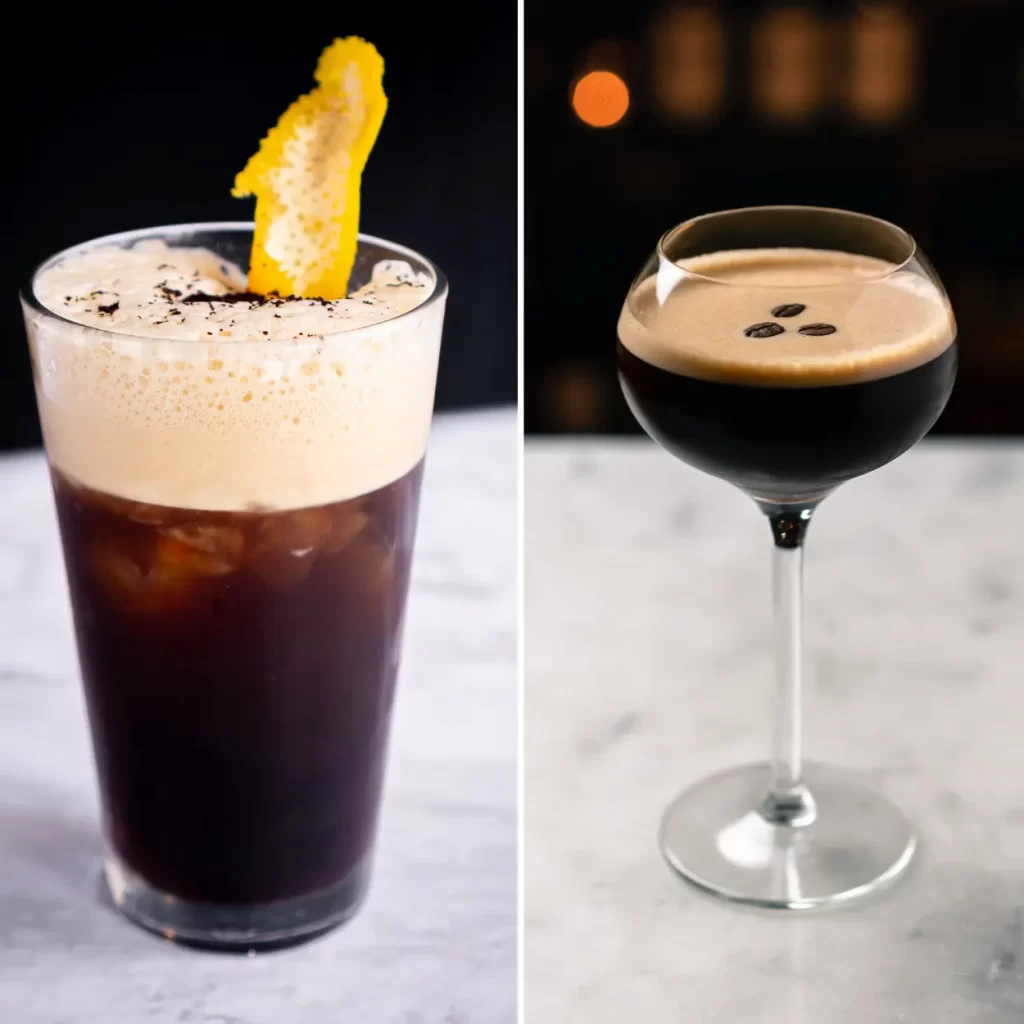
The flavor profiles of both the Carajillo and Espresso Martini are rich tapestries woven from diverse ingredients and intricate preparation methods. As we embark on this flavorful exploration, we’ll discover the unique sensory experiences each of these popular cocktails offers. Let’s taste and compare, shall we?
- Carajillo:
- The Carajillo’s flavor profile is deeply rooted in tradition and has a warmth that pairs perfectly with the robust nature of the coffee.
- Depending on the region, the spirit used varies – be it brandy, rum, or mezcal, each offering its unique taste.
- Complementary ingredients such as lemon peel and cinnamon add layers of complexity and contribute to a cocktail that is both soothing and invigorating.
- Espresso Martini:
- In contrast, the Espresso Martini exudes a balance of sophistication and indulgence.
- Its strength stems from the clarity of the vodka, while the coffee liqueur and fresh espresso lend a robust coffee flavor.
- Presented in an elegant Martini glass with a layer of frothy coffee-infused foam on top, the Espresso Martini is as visually appealing as it is delightful to taste.
The Cultural Significance of Carajillo and Espresso Martini
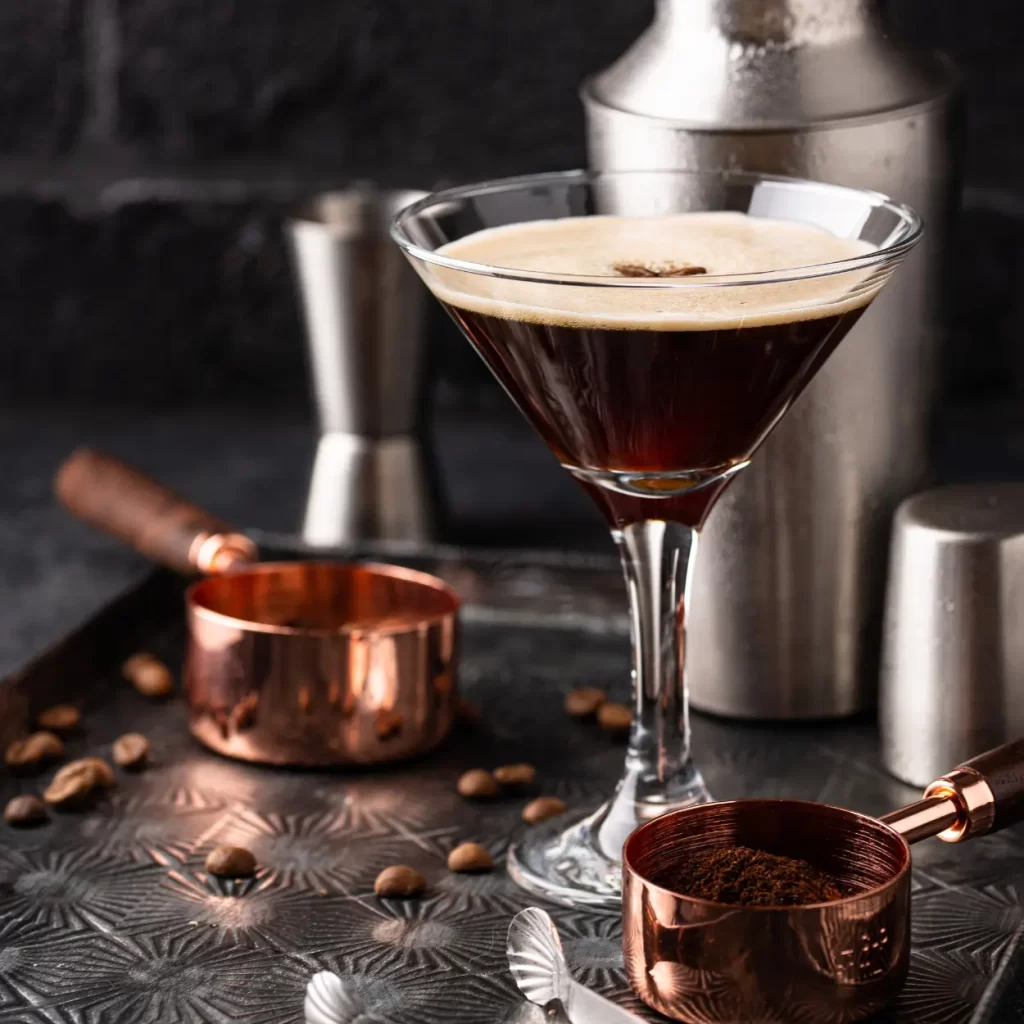
The cultural narratives of the Carajillo and Espresso Martini further distinguish these drinks. As we turn our attention to these two drinks, it’s intriguing to uncover the weight of tradition, adaptation, and cultural identity that these beverages carry. Join us as we explore the rich cultural narratives woven around these renowned coffee cocktails.
- Carajillo:
- Embodying a rich historical narrative linked to Spanish colonialism, the Carajillo is a comforting, traditional drink often savored casually at home or local taverns in Spain and Latin America.
- It stands as a symbol of resilience, courage, and warmth, intertwining itself in the daily lives of many cultures.
- Espresso Martini:
- Born from the lively cocktail scene of London, the Espresso Martini signifies innovation and creativity in the world of mixology.
- Often associated with indulgence and luxury, it finds a prominent place in upscale bars and restaurants, adding a dash of glamour to any occasion.
Occasions Suited for Each: When to Serve What
The ideal serving occasion for each cocktail reflects its flavor profile and cultural context. Every cocktail has its moment, a time, and a place where it truly shines. Whether it’s an after-dinner treat or a sophisticated party mixer, each drink has a special role to play. Let’s discover when it’s best to serve these remarkable coffee cocktails.
- Carajillo:
- Perfect for a cozy evening, the Carajillo, with its comforting warmth and robust flavor, serves as an excellent digestif post a hearty meal.
- Its rich, complex flavors make it suitable for casual social gatherings, offering a warm, laid-back experience.
- Espresso Martini:
- In contrast, the elegant Espresso Martini suits more formal occasions. As a pre-dinner cocktail, it sets a refined tone for the evening.
- Its sophisticated flavors and stylish presentation make it a hit at cocktail parties or receptions, adding a layer of glamour and indulgence.
In the Carajillo vs Espresso Martini comparison, the key takeaway is the unique and captivating journeys these coffee cocktails offer. Each has a distinct place in the world of mixology, providing a tantalizing exploration of coffee’s versatility.
Carajillo vs Espresso Martini: Advantages & Disadvantages
When it comes to coffee cocktails, the Carajillo and Espresso Martini are two beverages that often stand out, each offering a unique flavor profile and experience. However, how do they stack up against each other in terms of advantages and disadvantages? Let’s delve into the comparison of Espresso Martini vs Carajillo:
The Carajillo
Advantages:
- Versatility: The Carajillo can be prepared with various spirits, allowing the flexibility to suit different flavor preferences. Whether it’s the warmth of brandy, the sweetness of Licor 43, or the exotic notes of rum, the choice of spirit can significantly alter the Carajillo’s profile.
- Simplicity: The preparation of a Carajillo is straightforward, making it an easy choice for amateur mixologists. It doesn’t require complex ingredients or equipment.
- Cultural Significance: The Carajillo carries a rich history and cultural significance, particularly in Spain and Latin American countries. Enjoying this drink can be seen as participating in a cultural tradition.
Disadvantages:
- Heavy Taste: For some, the strong spirit flavors in a Carajillo might be overwhelming, especially when paired with potent coffee.
The Espresso Martini
Advantages:
- Smooth Flavor: The Espresso Martini, generally made with vodka, coffee liqueur, and espresso, offers a balanced and smooth flavor, making it a hit among those who prefer milder cocktails.
- Elegant Presentation: Served in a martini glass with a creamy froth on top, the Espresso Martini often looks as good as it tastes. Its sophisticated presentation is excellent for dinner parties or fancy gatherings.
- Variety: Similar to Carajillo, the Espresso Martini can also be varied by swapping the type of liqueur or adding other flavoring agents, offering a wide range of taste profiles.
Disadvantages:
- Complexity: The preparation of an Espresso Martini can be more intricate than a Carajillo, requiring precise measurements and more steps. This might not be ideal for those looking for a quick and easy mix.
- Specialized Equipment: To achieve the signature frothy top, you’ll need a cocktail shaker, which might not be a standard piece of equipment in every home bar.
In the contest of Carajillo vs Espresso Martini, each has its strengths and considerations. The choice between the two largely depends on personal preference, the occasion, and the individual’s cocktail-making skills.
DIY Coffee Cocktails: Tips and Tricks
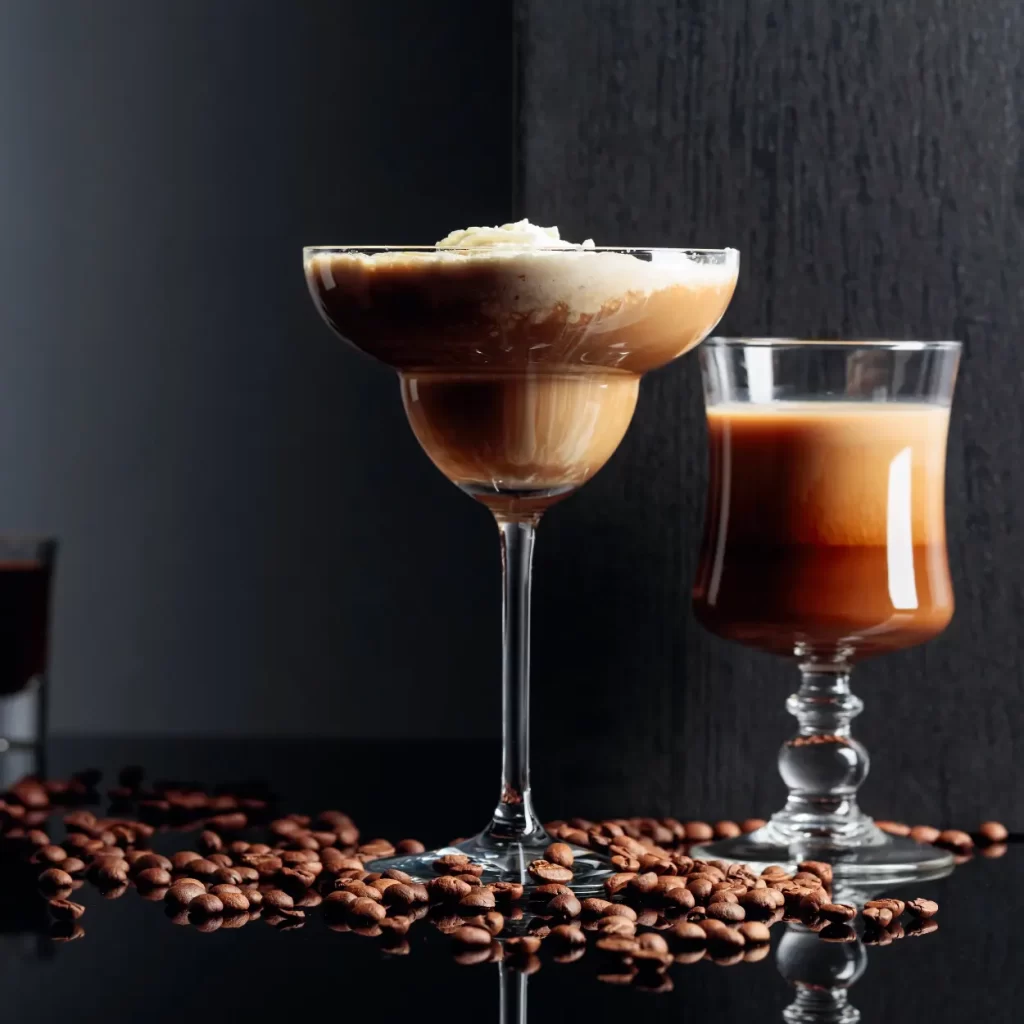
Creating coffee cocktails at home can be an adventure of its own, offering an exciting opportunity to bring out your inner mixologist. But, success requires knowledge, practice, and the right tools. Here, we share essential tips and tricks to help you craft exceptional coffee cocktails like the Carajillo and Espresso Martini right in your kitchen.
Selecting the Right Coffee Beans for Cocktails
The coffee beans you choose can make or break your cocktail. They form the bedrock of your drink’s flavor profile and can dramatically affect the overall taste and quality of your coffee cocktails.
- Quality Matters: Always opt for high-quality, fresh beans. Avoid pre-ground coffee, as it may have lost its flavor and aroma.
- Roast Profile: Different cocktails may call for different roast levels. Light roasts typically carry more acidity and fruity notes, while dark roasts are more bitter and bold. Medium roasts strike a balance and often work well in cocktails.
- Origins: Coffees from different parts of the world have unique flavor characteristics. Experiment with beans from various regions to see which you prefer in your cocktails.
- Grinding: The grind size should match your brewing method. For espresso-based cocktails, a fine grind is essential.
Essential Bar Tools for Home Coffee Cocktails
Equipping your home bar with the right tools will ease the process of making coffee cocktails. Here are the essentials:
- Espresso Machine or Coffee Maker: This is fundamental to brewing your coffee. Choose a model that suits your needs and budget.
- Shaker: A shaker is crucial for cocktails like the Espresso Martini that require vigorous mixing.
- Jigger: This tool helps you measure your ingredients accurately.
- Strainer: For smooth cocktails, a strainer can help you eliminate coffee grounds or ice shards.
- Bar Spoon: Useful for stirring and layering, a bar spoon is a must-have tool.
Secrets to Mastering Coffee Cocktails at Home
Perfecting coffee cocktails at home isn’t about just following recipes. It’s about understanding the nuances and applying some insider secrets:
- Temperature: Pay attention to the temperature of your coffee and other ingredients. It can significantly impact the final taste.
- Balance: Striking the right balance between the flavors is crucial. The coffee should complement the alcohol, not overpower it.
- Experiment: Don’t be afraid to try new things. Adding spices, using different spirits, or trying unique garnishes can lead to delightful results.
- Practice: The more you make these cocktails, the better you will get. Remember, practice makes perfect.
Embarking on your DIY coffee cocktail journey can be thrilling. Remember, the key to a great cocktail lies in understanding your ingredients, using the right tools, and having the courage to experiment. Cheers to your coffee cocktail adventures!
Conclusion
In conclusion, the exploration of the Carajillo vs Espresso Martini reveals a fascinating world of coffee cocktails, steeped in history and culture. The allure of these beverages lies not only in their potent concoctions but also in the tales they tell and the traditions they embody. The Carajillo, with its vibrant Spanish origins and Latin American adaptations, tells a tale of courage, warmth, and adaptation. On the other hand, the Espresso Martini, a blend of espresso’s robustness with the sophistication of a martini, stands as an innovative symbol of modern mixology. Both the Carajillo drink and Espresso Martini are testaments to the versatility of coffee, its remarkable ability to blend with various spirits, and its role in crafting unforgettable moments. Whether you’re seeking the familiarity of a well-made Carajillo or the modern charm of an Espresso Martini, each sip promises a unique journey into the captivating realm of coffee cocktails.
FAQ
How to make a Carajillo at home?
To make a Carajillo at home, you need strong, freshly brewed coffee or espresso, a spirit like brandy or rum, and optional additions like cinnamon and lemon peel; combine, heat, and serve hot.
What is the origin of the Espresso Martini?
The Espresso Martini originated in London in the 1980s when a British bartender created it for a model who asked for a drink that would "wake her up and mess her up."
Which coffee beans are best for coffee cocktails?
Arabica coffee beans, known for their balanced flavor and acidity, are typically best for coffee cocktails due to their robust and nuanced flavor profiles.
What are some variations of the classic Carajillo and Espresso Martini?
Variations of the classic Carajillo include the Mexican Carajillo with "Licor 43" served over ice, while a popular Espresso Martini variation is the "French Martini," incorporating pineapple juice and Chambord.
